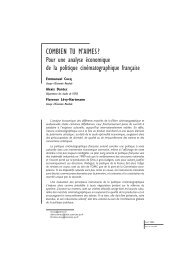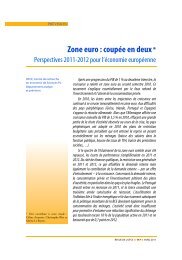direct multi-step estimation and forecasting - OFCE - Sciences Po
direct multi-step estimation and forecasting - OFCE - Sciences Po
direct multi-step estimation and forecasting - OFCE - Sciences Po
You also want an ePaper? Increase the reach of your titles
YUMPU automatically turns print PDFs into web optimized ePapers that Google loves.
Direct <strong>multi</strong>-<strong>step</strong> <strong>estimation</strong> <strong>and</strong> <strong>forecasting</strong><br />
in the model are correctly specified, so that Z 0 T +h<br />
= D0 T +h<br />
then (iia) is zero, <strong>and</strong> again the<br />
converse seems to hold. In the case of correct stochastic specification, so that ψ e T summarises the<br />
effects of X 1 T , then (iib) is zero; but now the converse is not true: (iib) can be zero in seriously<br />
misspecified models. Next, when the data are accurate (especially at the forecast origin), so that<br />
X = ˜X, (iii) is zero but the converse is unclear. When estimated parameters have zero variances, so<br />
[<br />
]<br />
T −r+1<br />
that ̂x T +h|T = E T ̂x T +h|T | ˜X<br />
T<br />
, D T +1<br />
T +h , ψe T , then (iv) is zero <strong>and</strong> the converse holds almost<br />
surely. Finally (v) is zero if <strong>and</strong> only if the world is non-stochastic.<br />
Thus, the taxonomy includes elements of the main sources of forecast error, partitioning these<br />
by whether or not the corresponding expectation is zero. For there to be a gain from DMS, it<br />
must be obtained through <strong>estimation</strong> uncertainty (iv), possibly interacting with misspecification<br />
of deterministic or stochastic elements, (iia) <strong>and</strong> (iib).<br />
This is why the literature has shown<br />
that <strong>direct</strong> mutli-<strong>step</strong> <strong>estimation</strong> is beneficial for <strong>forecasting</strong> essentially in two contexts: when<br />
the model is misspecified for the stochastic properties of the process (omitted unit-roots) or when<br />
deterministic properties alter <strong>and</strong> go unnoticed, as in the context of breaks, which may reinforce<br />
the previous type of misspecification via induced serial correlation of the residuals or long-memory.<br />
10 Conclusion<br />
This paper has presented a review of the existing work on <strong>direct</strong> <strong>multi</strong>-<strong>step</strong> <strong>estimation</strong> for <strong>forecasting</strong><br />
at varying horizons. We have show that this strain of literature has produced a vast amount<br />
of theoretical <strong>and</strong> empirical evidence favouring the use of this technique. Unfortunately, the diversity<br />
of approaches had made it difficult to draw a definite conclusion about its when’s <strong>and</strong> why’s.<br />
Here, we have shown that from the early contributions, the analyses have evolved towards either<br />
using DMS criteria for the design of <strong>forecasting</strong> models, or proper DMS <strong>estimation</strong>. In the light of<br />
our review, although the gain from using IMS or DMS varies with the horizon <strong>and</strong> the stochastic<br />
properties of the data, it is clear that the latter technique can be asymptotically more efficient<br />
than the former even if the model is well-specified. This result is explained by the improvement<br />
in the variance of the <strong>multi</strong>-<strong>step</strong> estimator resulting from <strong>direct</strong> <strong>estimation</strong>. It thus appears that<br />
the misspecification of the error process in the case of DMS <strong>estimation</strong> is not so detrimental to the<br />
accuracy of the estimators. However, the limiting distributions reflect only partially the <strong>estimation</strong><br />
38








